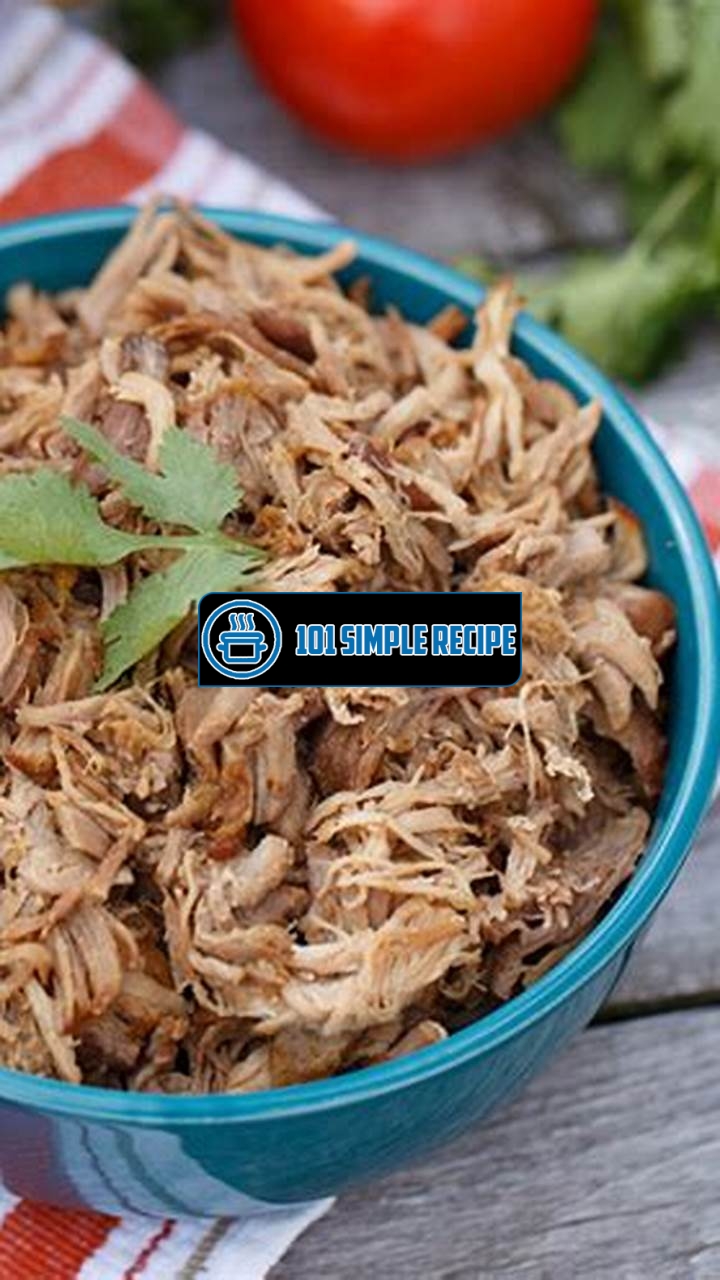Are you ready to embark on a culinary adventure filled with savory flavors and tender bites? Look no further, because this step-by-step guide will teach you how to make the most delicious carnitas. With its origins in Mexican cuisine, carnitas is a popular dish made from juicy and succulent pork that has been slow-cooked to perfection. ✨ Throughout this article, we will walk you through each stage of the cooking process, providing helpful tips along the way to ensure your carnitas turn out absolutely mouthwatering. So put on your apron and prepare for a gastronomic experience like no other!

Preparing the Pork
In this section, you will learn the initial steps in making delicious carnitas. It all starts with choosing the right cut of pork and marinating it properly. These steps are essential to achieving the perfect flavor and tenderness in your carnitas.
Selecting the Perfect Cut of Pork
To make the best carnitas, you need to select the right cut of pork. The most commonly used cuts for carnitas are pork shoulder or pork butt. These cuts are well-marbled with fat, which will contribute to the succulence and flavor of the dish. Fat equals flavor when it comes to carnitas, so don’t be afraid to choose a cut with some visible fat marbling.
When choosing your pork, look for a piece that is well-trimmed but still has a good amount of fat remaining. The fat will render down during the slow cooking process, keeping the meat moist and juicy. Aim for a piece of pork that weighs around 4 to 5 pounds, as this will yield enough carnitas to serve a crowd.
Marinating the Pork for Maximum Flavor
Marinating the pork is an essential step in creating flavorful carnitas. This step allows the meat to absorb the flavors of the marinade and become more tender. The traditional carnitas marinade consists of a combination of citrus juice, herbs, spices, and garlic.
To marinate the pork, you can use a large resealable plastic bag or a glass dish with a lid. Place the pork in the bag or dish and pour the marinade over it. Make sure the pork is fully submerged in the marinade, then seal the bag or cover the dish and refrigerate for at least 4 hours or overnight. This will give the flavors enough time to penetrate the meat.
Note: When marinating the pork, you can get creative with the flavors by adding ingredients like onions, chili peppers, or even beer. Experiment with different combinations to find your favorite carnitas marinade.
Slow Cooking the Pork to Perfection
The final step in making carnitas is slow cooking the marinated pork. This is where the magic happens and the meat transforms into tender, flavorful perfection. Traditionally, carnitas are cooked by braising the pork in lard or oil until it becomes fork-tender.
To slow cook the pork, you will need a large, heavy-bottomed pot or Dutch oven. Heat the pot over medium-high heat and add enough lard or oil to coat the bottom. Once the fat is hot, carefully place the marinated pork in the pot and brown it on all sides. This will add additional flavor and texture to the carnitas.
Once the pork is nicely browned, reduce the heat to low and cover the pot. Let the pork simmer gently for 2 to 3 hours, or until it is fork-tender. During this time, the fat will render down, and the flavors of the marinade will infuse the meat. The slow cooking process is what gives carnitas their signature tenderness and taste.
Note: If you prefer a healthier version of carnitas, you can also cook the marinated pork in a slow cooker or Instant Pot. These methods will still yield delicious results while minimizing the amount of added fat.
By following these steps, you can create your own mouthwatering carnitas at home. The right cut of pork, a flavorful marinade, and slow cooking are the keys to achieving the perfect texture and taste. Whether you serve them in tacos, burritos, or on their own, your homemade carnitas are sure to impress!
Carnitas recipe with a twist: White Castle inspired carnitas
Flavorful Seasoning and Spices
Discover the key ingredients and spices that give carnitas its distinct taste and aroma.
The Essential Seasonings for Authentic Carnitas
When it comes to making authentic carnitas, the right seasonings are essential. These spices not only give the meat its distinct flavor but also infuse it with a rich aroma that will make your mouth water.
- Cumin: This earthy and warm spice adds depth to the carnitas. It has a slightly nutty and smoky flavor that complements the pork perfectly.
- Oregano: The addition of oregano brings a touch of herbal freshness to the dish. It balances out the richness of the meat and adds a delightful aroma.
- Paprika: Paprika is known for its vibrant red color and mild spiciness. It adds a gentle heat to the carnitas and enhances the overall flavor profile.
- Garlic Powder: A staple in many savory dishes, garlic powder lends its distinct flavor to the carnitas. It provides a savory and slightly sweet taste that complements the pork beautifully.
- Onion Powder: Onion powder adds a subtle sweetness and depth of flavor to the carnitas. It brings out the natural sweetness of the pork and elevates the overall taste.
Note: The exact measurements for these seasonings may vary based on personal preference. Feel free to adjust the quantities according to your taste.
Exploring Traditional Mexican Spices
Mexican cuisine is known for its bold and vibrant flavors. When it comes to carnitas, traditional Mexican spices play a crucial role in creating an authentic and mouthwatering dish.
In addition to the essential seasonings mentioned above, traditional Mexican spices like chili powder, coriander, and cinnamon add a unique depth and complexity to the carnitas.
- Chili Powder: This spice blend typically includes chili peppers, cumin, oregano, and garlic powder. It adds a spicy kick and a robust flavor to the carnitas.
- Coriander: Ground coriander seeds have a mild citrusy flavor that pairs well with pork. It adds a subtle brightness to the dish, enhancing the overall taste.
- Cinnamon: A surprising addition to carnitas, cinnamon adds a warm and sweet note to the savory meat. It infuses the carnitas with a delightful aroma and complexity.
Note: Traditional Mexican spices can be found in most grocery stores or specialty spice shops. Don’t be afraid to experiment with different brands and variations to find the ones that suit your taste preferences best.
Experimenting with Unique Flavor Combinations
While the essential seasonings and traditional Mexican spices create a delicious base for carnitas, you can take your dish to the next level by experimenting with unique flavor combinations.
Consider adding a touch of sweetness with ingredients like brown sugar or honey. The sweetness helps balance out the savory flavors and adds a delightful caramelized note to the meat.
You can also try incorporating citrus flavors by adding fresh lime or orange juice to the marinade. The acidity of the citrus fruits helps tenderize the meat while infusing it with a tangy and refreshing taste.
For those who prefer a spicier kick, consider adding diced jalapenos or even a dash of hot sauce to the marinade. The heat will elevate the flavors and add a fiery element to your carnitas.
Remember, the key to creating delicious carnitas lies in finding the perfect balance of flavors that suits your taste buds. Don’t be afraid to get creative and tweak the seasonings and spices until you achieve the perfect combination.
So, whether you’re a fan of traditional Mexican spices or love experimenting with unique flavors, the seasoning and spices you choose will play a significant role in creating mouthwatering carnitas that will leave you craving more.
The Art of Crispy Carnitas
Mastering the technique to achieve crispy and tender carnitas is essential if you want to create the hallmark of this beloved dish. Carnitas, which translates to “little meats,” are a popular Mexican dish that is typically made from pork. The key to achieving that perfect combination of crispy and tender meat lies in the cooking process. By following a few secrets and tips, you can elevate your carnitas to a whole new level of deliciousness.
Secrets to Achieving Crispy Caramelized Bits
One of the most coveted elements of carnitas is the crispy caramelized bits that form on the meat. These flavorful morsels add an irresistible texture to the dish. To achieve these crispy bits, there are a few secrets you need to know:
- Use the right cut of pork: Traditional carnitas are made using pork shoulder or pork butt. These cuts have a good balance of fat and meat, which is vital for achieving the desired texture.
- Render the fat: Before cooking the meat, you can render some of the fat to help with the caramelization process. This can be done by searing the meat in a hot pan before transferring it to the cooking vessel.
- Optimize the cooking temperature: Cooking carnitas at a slightly higher temperature can help in achieving crispy bits. However, be careful not to overcook the meat, as it should still be tender and moist.
Note: Remember to always prioritize safety when cooking meat. Ensure that the pork is cooked to the appropriate temperature to avoid any potential health risks.
Tips for Tender and Moist Meat
In addition to achieving crispy caramelized bits, tender and moist meat is equally important in creating the perfect carnitas. Here are a few tips to help you ensure the meat remains tender and juicy:
- Slow cooking is key: Carnitas are traditionally cooked over a low heat for an extended period. This slow cooking allows the collagen in the pork to break down, resulting in tender and juicy meat.
- Add flavor through seasoning: A well-seasoned marinade or dry rub can enhance the flavor of the meat and help keep it moist. Experiment with spices like cumin, oregano, garlic, and citrus juices to create a delicious marinade.
- Braise the meat: After browning the pork, braising it in a flavorful liquid, like broth or citrus juice, can further enhance the tenderness and moisture of the meat.
Methods for Perfectly Balancing Texture and Flavor
Perfectly balancing the texture and flavor of your carnitas is the final step in creating a truly exceptional dish. Here are a few methods you can use:
- Shred the meat: Once the meat is cooked, shred it into smaller pieces. This allows for a more even distribution of flavor and gives a pleasant texture to each bite of carnitas.
- Crisp up the meat: After the meat is cooked and shredded, you can crisp it up further by pan-frying or baking it. This step adds an additional layer of texture and intensifies the flavors.
- Balance with accompaniments: While carnitas can be enjoyed on their own, they are often served with various accompaniments like tortillas, salsas, and fresh cilantro. These accompaniments provide contrasting flavors and textures that complement the carnitas.
By following these secrets, tips, and methods, you can become a master of crispy and tender carnitas. Take your time, experiment with flavors, and enjoy the process of creating this delicious dish. Whether it’s for a casual weeknight dinner or a festive gathering, your homemade carnitas are sure to impress.
A healthier version of carnitas for weight loss enthusiasts
Choosing the Perfect Garnishes
When it comes to enjoying delicious carnitas, the right garnishes can take your meal to the next level. These accompaniments not only add flavor and texture but also enhance the visual appeal of your dish. Whether you prefer traditional toppings or creative garnish ideas, there are plenty of options to explore. Let’s dive in and discover the perfect garnishes for your carnitas.
Traditional Toppings for Authentic Mexican Carnitas
For those seeking an authentic Mexican experience, traditional toppings are the way to go. They provide a classic, time-tested flavor profile that complements the rich taste of carnitas. Here are some must-try options:
- Salsa verde: This tangy and spicy green salsa adds a burst of freshness to your carnitas. Its bright flavor cuts through the richness of the meat, creating a harmonious balance.
- Pickled red onions: These thinly sliced onions add a vibrant pop of color to your dish. Their tangy and slightly sweet taste provides a delightful contrast to the savory carnitas.
- Cilantro and onion: A classic combination, chopped cilantro and onions bring a refreshing element to your carnitas. The crunchiness of the onions and the herbal notes of cilantro complement the flavors perfectly.
- Guacamole: Creamy and smooth, guacamole is a staple topping for any Mexican dish. Its buttery texture and rich avocado flavor elevate the taste of your carnitas.
Creative and Modern Garnish Ideas
If you’re looking to add a modern twist to your carnitas, these creative garnish ideas will do the trick. They bring new flavors and textures to the table, giving your dish a unique and exciting twist:
- Pineapple salsa: Sweet and tangy, pineapple salsa adds a tropical touch to your carnitas. The combination of juicy pineapple, spicy peppers, and zesty lime creates a burst of flavors.
- Chipotle mayo: Creamy and smoky, chipotle mayo adds a layer of indulgence to your carnitas. Its spicy kick and velvety texture make every bite a delight.
- Crispy fried jalapenos: For those who enjoy a bit of heat, crispy fried jalapenos are a game-changer. They provide a crunchy texture and a fiery kick that pairs perfectly with the succulent carnitas.
- Mango avocado salsa: This fruity and creamy salsa brings a tropical vibe to your carnitas. The combination of sweet mango, creamy avocado, and zesty lime creates a refreshing and delightful topping.
Serving Suggestions and Side Dishes
When it comes to serving your carnitas, there are numerous options to consider. The right side dishes and serving suggestions can enhance the overall dining experience. Here are some ideas to inspire you:
- Warm tortillas: Serve your carnitas with warm, freshly made tortillas. They provide a soft and comforting base for your meat, allowing you to create flavorful tacos or burritos.
- Mexican rice: A classic side dish, Mexican rice adds a savory note to your meal. Its fluffy texture and aromatic flavors complement the carnitas perfectly.
- Refried beans: Creamy and rich, refried beans are a staple side dish in Mexican cuisine. They add a satisfying and hearty element to your plate.
- Charred corn: Grilled or roasted corn on the cob brings a smoky and sweet flavor to your carnitas. Its juicy kernels provide a burst of freshness.
With these garnish ideas and serving suggestions, you can create a memorable and delicious carnitas experience. Experiment with different flavors and combinations to find your perfect match. Whether you prefer traditional toppings or modern twists, the key is to let your taste buds guide you. Enjoy the journey of exploring the world of garnishes and take your carnitas to new heights of culinary delight!
Variations and Adaptations
When it comes to carnitas, there are endless possibilities for putting a unique spin on this classic recipe. Whether you’re catering to different dietary preferences or simply looking for new and exciting flavors, here are some variations and adaptations to consider:
Healthier Alternatives for Guilt-Free Carnitas
If you’re watching your calorie intake or looking for a healthier option, there are several ways to make guilt-free carnitas. Here are a few ideas:
- Add more vegetables: Increase the amount of vegetables in your carnitas recipe to boost the nutritional value. Bell peppers, onions, and carrots are great options that add color and texture to the dish. ️
- Trim the fat: While traditional carnitas are known for their crispy exterior, you can reduce the amount of fat used in the recipe. Trim excess fat from the pork before cooking or opt for leaner cuts of meat.
- Bake instead of fry: Instead of deep-frying the pork, try baking it in the oven. This will result in a healthier version of carnitas without sacrificing the delicious flavors.
- Use whole grain tortillas: Instead of serving carnitas with regular flour tortillas, opt for whole grain tortillas for added fiber and nutrients. They are just as tasty and will keep you feeling satisfied. ️
Fusion Flavors: Combining Carnitas with International Cuisines
If you’re in the mood for something different, why not try combining carnitas with flavors from around the world? Here are some fusion ideas to get you started:
- Mexican-Asian fusion: Create a flavorful fusion dish by adding soy sauce, ginger, and garlic to your carnitas marinade. Serve the carnitas in lettuce wraps with a side of Asian slaw for a refreshing twist.
- Mexican-Italian fusion: Combine the richness of carnitas with the flavors of Italian cuisine. Top your carnitas with tomato sauce, mozzarella cheese, and fresh basil for a mouthwatering carnitas pizza.
- Mexican-Mediterranean fusion: Add a Mediterranean touch to your carnitas by serving them with a side of tzatziki sauce, a Greek salad, and warm pita bread. The combination of flavors will transport you to the sunny beaches of the Mediterranean. ️
Vegan and Vegetarian Carnitas Options
For those following a plant-based diet, you can still enjoy the mouthwatering flavors of carnitas with these vegan and vegetarian options:
Jackfruit carnitas: Replace the pork with young jackfruit, which has a similar texture to pulled meat. Cook the jackfruit with the same spices and seasonings as traditional carnitas, and you’ll have a delicious vegan alternative.
These variations and adaptations allow you to experiment with flavors and cater to different dietary preferences. Whether you’re looking for a healthier version, exploring international fusions, or opting for plant-based alternatives, there’s no limit to the deliciousness you can create with carnitas. Get creative and enjoy the journey of discovering new flavors!
Indulge in some delicious carnitas with a warm cookie in a mug
Thank you for reading this article on how to make carnitas! We hope you found the instructions and tips helpful in creating a delicious meal. If you enjoyed this recipe, be sure to bookmark our page and visit again later for more mouthwatering recipes and cooking inspiration. Happy cooking!
Frequently Asked Questions
Here are some frequently asked questions about making carnitas:
| No. | Questions | Answers |
|---|---|---|
| 1 | What cut of pork is best for carnitas? | The best cut of pork for carnitas is usually pork shoulder or pork butt. These cuts are well-marbled and contain enough fat to keep the meat tender and juicy during the slow cooking process. |
| 2 | Can I make carnitas in a slow cooker? | Yes, you can definitely make carnitas in a slow cooker. Simply follow the recipe instructions and adjust the cooking time according to your slow cooker’s settings. The result will be flavorful and tender carnitas. |
| 3 | Can I use chicken instead of pork for carnitas? | While traditionally carnitas is made with pork, you can certainly experiment with using chicken. Just keep in mind that the cooking time and flavors may vary. Be sure to adjust the ingredients and cooking method accordingly. |
| 4 | Are carnitas spicy? | Carnitas can be made with varying levels of spiciness, depending on your preference. The recipe provided in this article has a mild level of spiciness, but you can adjust the amount of spices and chili peppers to make it spicier or milder. |
| 5 | What are the best toppings to serve with carnitas? | Some popular toppings for carnitas include diced onions, chopped cilantro, sliced radishes, and fresh lime juice. These toppings add a refreshing and tangy contrast to the rich flavors of the carnitas. |
| 6 | Can I freeze leftover carnitas? | Yes, you can freeze leftover carnitas for future use. Make sure to store them in an airtight container or freezer bags. When you’re ready to enjoy them again, simply thaw and reheat them in a skillet or oven. |
Thank You for Reading!
We hope you’ve enjoyed learning how to make carnitas. With the right ingredients and techniques, you’ll be able to recreate this classic Mexican dish in your own kitchen. Don’t forget to share your experience with us and visit our website again for more delicious recipes and culinary inspiration. Happy cooking!
Jump to Recipe
Carnitas Recipe

Learn how to make flavorful and tender carnitas with this easy recipe. Perfect for tacos, burritos, and more!
- 3 lbs pork shoulder (cut into chunks)
- 1 onion (diced)
- 4 cloves garlic (minced)
- 2 oranges (juiced)
- 1 lime (juiced)
- 1 jalapeno pepper (seeded and diced)
- 2 tsp ground cumin
- 2 tsp dried oregano
- 1 tsp smoked paprika
- Salt and pepper to taste
- 2 tbsp vegetable oil
- In a large bowl, combine the pork shoulder chunks, diced onion, minced garlic, orange juice, lime juice, diced jalapeno, cumin, oregano, smoked paprika, salt, and pepper. Mix well to coat the pork evenly with the marinade. Cover and refrigerate for at least 2 hours or overnight.
- Heat the vegetable oil in a large Dutch oven or heavy-bottomed pot over medium-high heat. Remove the pork from the marinade, allowing any excess marinade to drip off, and add it to the pot. Cook the pork in batches until browned on all sides, about 5 minutes per batch.
- Return all the browned pork to the pot and pour in the remaining marinade. Bring to a boil, then reduce the heat to low and simmer, covered, for about 2 hours or until the pork is tender and easily shreds.
- Once the pork is tender, remove it from the pot and shred it using two forks. Heat a large skillet over medium-high heat and add the shredded pork. Cook for a few minutes until the edges are crispy and browned.
- Serve the carnitas in tacos, burritos, or any other way you prefer. Top with your favorite toppings such as diced onions, chopped cilantro, sliced radishes, and a squeeze of fresh lime juice. Enjoy!






